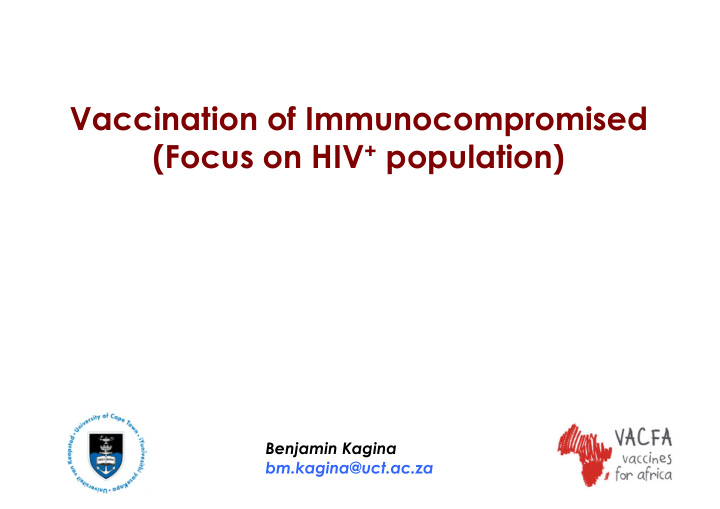



Vaccination of Immunocompromised (Focus on HIV + population) Benjamin Kagina bm.kagina@uct.ac.za
• Primary: Naturally occurring defects of innate or acquired immunity, usually inherited as single-gene disorders • Secondary: Arise when immunologically intact individuals develop altered immune function as a result of exogenous factors (eg, HIV infection) Slide adapted from Brian Eley talk (Vaccinology 2013)
PRIMARY IMMUNODEFICIENCY DISEASES Humoral deficiencies Severe antibody deficiencies e.g. X-linked agammaglobulinaemia, Common variable immunodeficiency Less severe antibody deficiencies e.g. IgA deficiency, IgG subclass deficiency Cell-mediated deficiencies Complete defects e.g. severe combined immunodeficiency, complete DiGeorge syndrome Partial defects e.g. most patients with DiGeorge syndrome, Wiscott-Aldrich syndrome, ataxia telangiectasia Complement deficiencies Early components e.g. C1, C4, C2, C3 deficiencies Late components e.g. C5-C9, properdin and factor B deficiencies Phagocytic disorders Chronic granulomatous disease, leukocyte adhesion defects, myeloperoxide deficiency Disorders affecting the Leucocyte Mycobactericidal defects e.g. IL-12 & IL-23 interferon-gamma pathway receptor β 1 chain deficiency, IFN- γ receptor 1 & 2 deficiency, STAT1 deficiency SECONDARY IMMUNODEFICIENCIES HIV / AIDS Glucocorticosteroids Functional hyposplenia / Asplenia Immunosuppressive therapy, radiation therapy, solid organ transplant recipients Bone marrow transplant recipients Adapted from: American Academy of Pediatrics Red Book, 28 th edition, 2009
BCG contraindication in SCID SCID diagnosis approach: Japanese SCID case of disseminated BCG No B/ NK cells Note: prevalence @ 1 in 65,000 births Takahiro Satoh, et al.2012 Acta Derm Venereol 92
Efficacy of 13-Valent Pneumococcal Conjugate Vaccine (PCV-13) against Invasive Pneumococcal Disease (IPD): Impact of immunocompromising conditions MMWR / June 28, 2013 / Vol. 62 / No. 25
Vaccination of HIV + population Introduction -HIV-infection negatively affects the immune response to vaccines through: a) B cell dysfunctions b) Immune activation/impaired cell-mediated immunity c) Net state of immunosuppresion
BCG contraindication in immunocompromised children Not only ineffective, but may also be risky: disseminated BCG disease in HIV+ infants Hesseling, et al. Bull World Health Organ vol.87 n.7 Genebra Jul. 2009
http://gamapserver.who.int/mapLibrary/app/searchResults.aspx
HIV + prevalence peaks later in life Increasing HIV prevalence Decreasing vaccine-induced immunity Figure adapted from the SA national academy of sciences
Solen et al. CID 2014:58 (15 April)
Solen et al. CID 2014:58 (15 April)
Meta-analysis of the percentages of seroprotection 5 years after the last vaccine dose Solen et al. CID 2014:58 (15 April)
Meta-analysis of the percentages of seroprotection 5 years after the last vaccine dose Solen et al. CID 2014:58 (15 April)
Long-term Immune Responses to Vaccination in HIV- Infected Patients: Summary of key findings: 1) Anti–HBs virus antibodies should be measured yearly in adults and every 2–5 years in children 2) Anti–hepatitis A virus antibodies should be monitored every 5 years 3) For tetanus, the interval of 10 years between boosters seems reasonable. 4) For measles, the initial vaccination should include 2 doses, ideally administered after the start of HAART. A third dose could be proposed 2–5 years after primary vaccination. Solen et al. CID 2014:58 (15 April)
Interventions to improve immunity in HIV-infected persons: Systematic review -278 studies were selected based on titles and abstracts -After screening for duplicates, 130 studies were included Children, adolescents and adults studies Adults=79 (62%) All=18 (12%) Children=33 (26%) Ongoing study
Interventions to improve immunity in HIV-infected persons: Systematic review. Vaccines studied Ongoing study
Interventions to improve immunity in HIV-infected persons: Systematic review Main intervention is HAART HAART=114 (87%) No HAART=16 (13) Ongoing study
Interventions to improve immunity in HIV-infected persons: Systematic review Together with HAART (n=114), interventions evaluated are: Revaccination/Booster=58 Route of vaccination=3 Prime/Boost=6 Micronutients=3 Increased dose=12 IL-2 + revaccination=1 Adjuvant + dose=12 Adjuvant=17 Accelerated schedule=2 Ongoing study
Interventions to improve immunity in HIV-infected persons: Systematic review: Duration of immunogenicity evaluations Ongoing study
Interventions to improve immunity in HIV-infected persons: Systematic review Studies by continent Africa=16 Asia=22 Europe=33 Multisites=4 North America=39 South America=10 Unclear=6 Ongoing study
Interventions to improve immunity in HIV-infected persons: Systematic review Preliminary conclusions 1) More studies done in adults than young children 2) Majority of the studies have assessed influenza and HBV 3) HAART and revaccination/booster strategy most assessed 4) Majority of studies have not evaluated immune responses beyond 1year after the intervention 5) Number of studies done in African countries do not match the scale of the HIV epidemic on the continent Ongoing study
Safety of vaccines in HIV-infected population: Measles
Safety of vaccines in HIV-infected population: PCV
Safety of vaccines in HIV-infected population: YF
Safety of vaccines in HIV-infected population: Routine vaccines Ongoing study
Vaccination of HIV + population Future outlook in the context of South Africa/LMICs -Burden of VPD in HIV infected and adults: incomplete data? -Evaluation of vaccination programs: Can this be extended to adolescents and adults? -Interventions to improve vaccine uptake among HIV- infected adolescents and adults? -Formal policy of vaccinating HIV-infected persons?
Acknowledgements -Greg Hussey (UCT, SA) -Shabir Madhi (NICD, SA) -Charles Wiysonge (SUN, SA) -Lesosky Maia (UCT, SA) -Leila Abdullahi (UCT, SA) -Violette Dirix (ULB, Belgium) -Sara Suliman (UCT) Thank you!
Recommend
More recommend